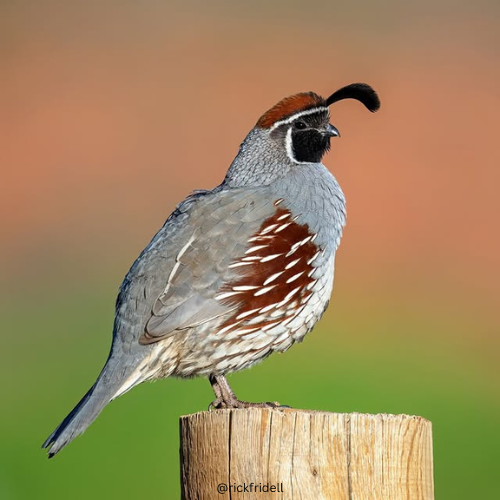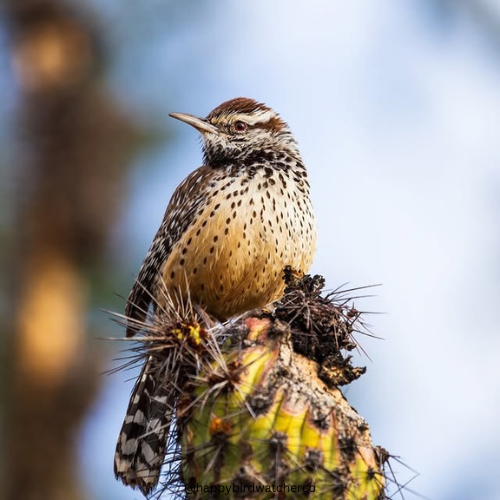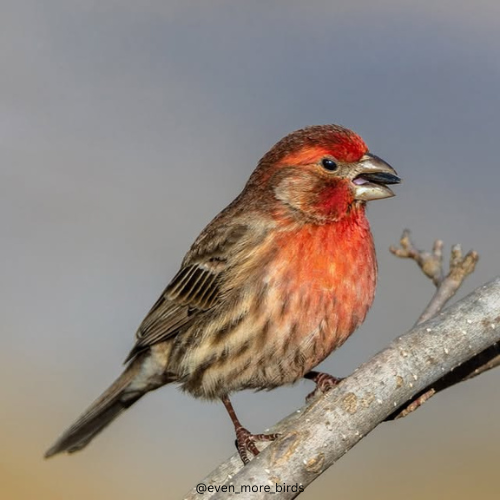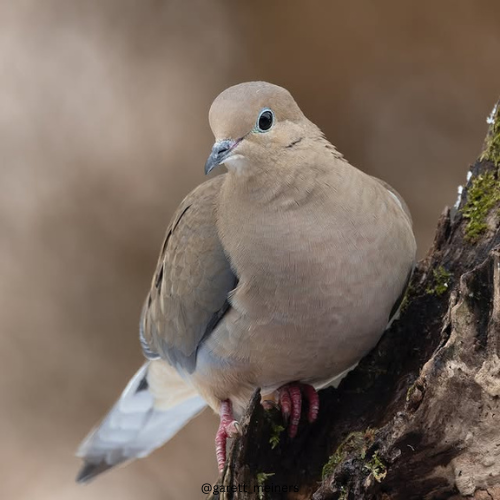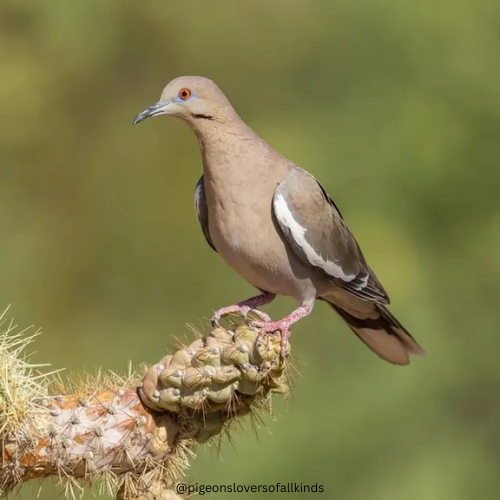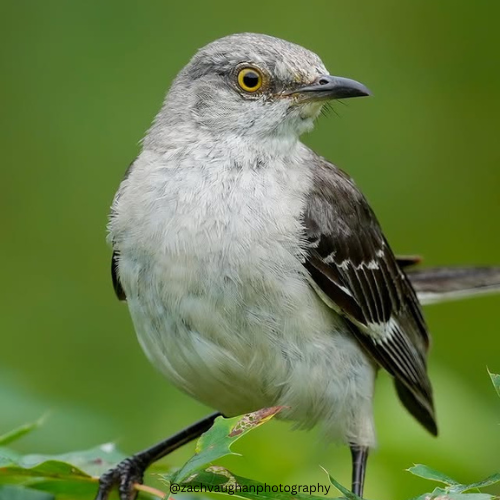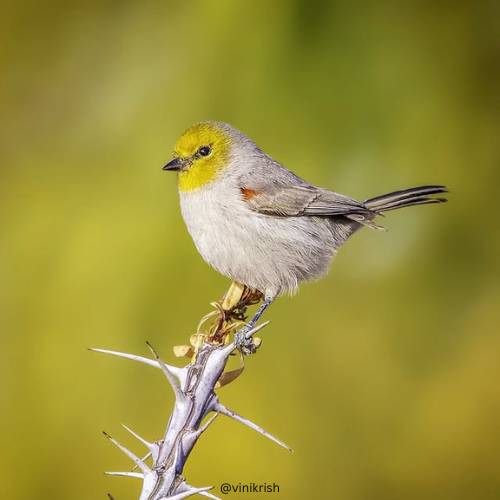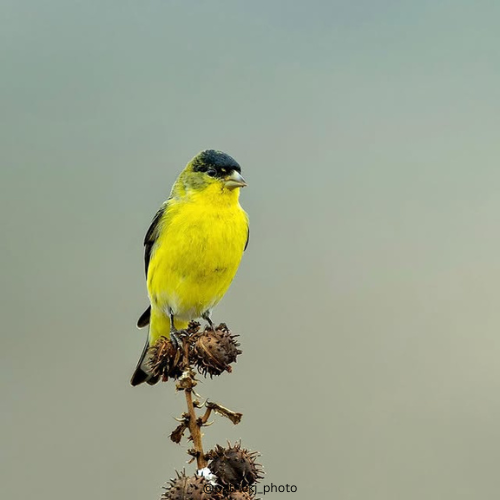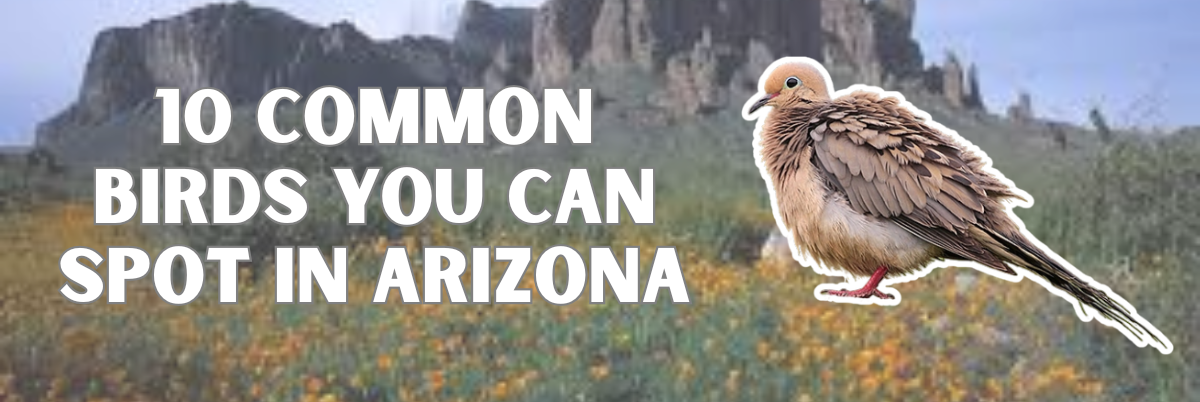
By Avian Feathers Team
Published June 2025
Arizona is full of birdlife. From backyard feeders to desert trails and mountain forests, birds are everywhere. Some sing from the rooftops. Others scurry through dry brush or dart between cactus spines.
If you’re just starting out with birdwatching, these ten species are a great place to begin.
1. Gambel’s Quail
This desert favorite is easy to recognize by the little topknot feather on its head. Gambel’s Quail often travel in groups and prefer to walk or run instead of fly. They make a funny “ka-KAA-ka” call that you’ll hear before you see them. You’ll often spot them scurrying across trails or hiding under shrubs.
Size
Length: 9.8–11.8 in (25–30 cm)
Wingspan: 13.4–14.6 in (34–37 cm)
Weight: 5.6–7.1 oz (160–200 g)
Scientific Name: Callipepla gambelii
2. Cactus Wren
This is Arizona’s state bird, and it fits the desert perfectly. Cactus Wrens have spotted bellies, bold white eyebrows and loud scratchy voices. They build bulky nests in cactus plants and are active and curious. You’ll see them hopping around with their tails cocked upward.
Size
Length: 7.1–9.1 in (18–23 cm)
Wingspan: 10.5–11.5 in (27–29 cm)
Weight: 1.2–1.7 oz (35–48 g)
Scientific Name: Campylorhynchus brunneicapillus
3. House Finch
House Finches are small, social and often found around feeders. Males have red faces and chests, while females are streaky brown. They sing cheerful songs and adapt well to cities, suburbs and farms. You’ll see them in flocks, especially in the cooler months.
Size
Length: 5–6 in (13–15 cm)
Wingspan: 8–10 in (20–25 cm)
Weight: 0.6–0.9 oz (16–27 g)
Scientific Name: Haemorhous mexicanus
4. Mourning Dove
Soft and slender, Mourning Doves are gentle birds with a long pointed tail. Their mournful “coo-OO-oo” call gives them their name. They’re commonly seen on wires, fences and walking around on the ground. When they take off, their wings make a sharp whistling sound.
Size
Length: 9–13.5 in (23–34 cm)
Wingspan: 17–18 in (43–46 cm)
Weight: 3.4–6 oz (96–170 g)
Scientific Name: Zenaida macroura
5. White-winged Dove
Larger than the Mourning Dove, this bird has a white edge on its wing that shows in flight. White-winged Doves are common in urban areas and desert towns. Their call sounds like “who cooks for you.” They love saguaro fruit and are most active during summer.
Size
Length: 10.5–12 in (27–30 cm)
Wingspan: 18–22 in (46–56 cm)
Weight: 4–6 oz (114–170 g)
Scientific Name: Zenaida asiatica
6. Northern Mockingbird
Mockingbirds are great singers. They mimic other birds and repeat each phrase two or three times. They are slender, gray birds with white flashes on their wings when they fly. Mockingbirds are bold and often perch in plain view, especially while defending their territory.
Size
Length: 8.3–10.2 in (21–26 cm)
Wingspan: 12–15 in (31–38 cm)
Weight: 1.4–2 oz (40–58 g)
Scientific Name: Mimus polyglottos
7. Gila Woodpecker
This woodpecker is common in desert areas, especially where saguaros grow. It has a black-and-white barred back and a red cap on the male’s head. Gila Woodpeckers often drum loudly on metal signs or poles. They also nest in holes they carve into cacti.
Size
Length: 8.7–9.4 in (22–24 cm)
Wingspan: 15–16 in (38–41 cm)
Weight: 1.8–2.8 oz (51–80 g)
Scientific Name: Melanerpes uropygialis
8. Verdin
Small but lively, Verdins are desert birds with yellow heads and gray bodies. They often hang upside down on branches while looking for insects. They are usually quiet but stay busy all day. You’ll see them darting among mesquite trees and desert shrubs.
Size
Length: 4.5 in (11 cm)
Wingspan: 6.7 in (17 cm)
Weight: 0.2–0.3 oz (5–9 g)
Scientific Name: Auriparus flaviceps
9. Curve-billed Thrasher
This dusty-brown bird has a long, curved bill and a loud “whit-wheet” call. It’s built for desert living and loves to scratch around in the dirt. Curve-billed Thrashers are often seen perched on fences, walls or cactus tops. They are bold and not easily scared.
Size
Length: 10–12 in (25–30 cm)
Wingspan: 13–15 in (33–38 cm)
Weight: 2.3–3.3 oz (65–95 g)
Scientific Name: Toxostoma curvirostre
10. Lesser Goldfinch
These bright yellow birds bring a pop of color to Arizona’s feeders and gardens. Males are shiny black and yellow, while females are more olive. Lesser Goldfinches travel in flocks and sing a cheerful, jumbled song. They love sunflower seeds and thistle plants.
Size
Length: 3.5–4.7 in (9–12 cm)
Wingspan: 6–8 in (15–20 cm)
Weight: 0.3–0.4 oz (8–11 g)
Scientific Name: Spinus psaltria
Where to Spot Common Birds in Arizona
Arizona is full of birdlife. From backyard feeders to desert trails and mountain forests, birds are everywhere. If you’re just starting out with birdwatching, these ten species are a great place to begin, often found in these spots:
- Gambel’s Quail: Look for these desert favorites scurrying across trails or hiding under shrubs.
- Cactus Wren: Spot Arizona’s state bird hopping around cactus plants, where they often build their bulky nests, especially in the desert.
- House Finch: Often found around feeders and in cities, suburbs, and farms, usually in flocks.
- Mourning Dove: Commonly seen on wires, fences, or quietly walking around on the ground.
- White-winged Dove: Common in urban areas and desert towns, often near saguaros (for fruit).
- Northern Mockingbird: You’ll find them perched on rooftops, fences, or treetops, singing loudly.
- Gila Woodpecker: Common in desert areas, especially where saguaros grow, often seen drumming on poles or nesting in cacti.
- Verdin: Look for these small birds darting among mesquite trees and desert shrubs.
- Curve-billed Thrasher: Often seen perched on fences, walls, or cactus tops, or scratching in the dirt in desert habitats.
- Lesser Goldfinch: These bright birds frequent feeders and gardens, traveling in flocks.
Birdwatching in Arizona is full of surprises, even in your own backyard.
Which of these birds have you seen around your neighborhood? Let us know which one is your favorite.

